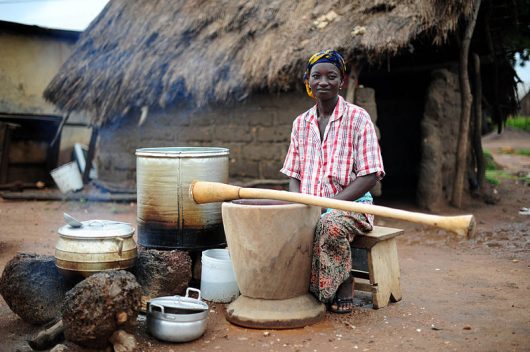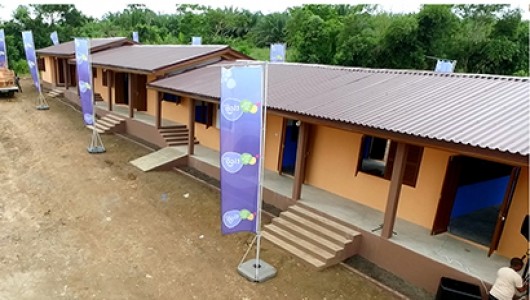
Once hailed as a rising star by the World Bank, Ghana has experienced significant macroeconomic challenges during the past five years that have severely undermined its social stability and resulted in fluctuating poverty levels. In 2022, the country’s inflation rate reached a record high of 54%, contributing to high public debt levels – nearly 90% of the GDP – and pushing millions into poverty. Although Ghana today has made strides in restoring stability and catalyzing growth, the pressure of high inflation has worsened poverty levels throughout the country, particularly in rural areas. State restructuring programs and humanitarian aid are both vital to providing poverty alleviation and ensuring a road of recovery for not only those suffering from poverty but for the country as a whole.
Rural Poverty: Smallholder Farmers and Women
As of 2023, around 2.99 million Ghanaians were living in extreme poverty. Out of this number, an overwhelming 2.3 million were located in rural regions, constituting a majority of the multidimensionally poor.
- Rural smallholder farmers, who produce 95% of the country’s crops, are among the poorest socioeconomic groups in Ghana. Most of these farmers reside in the northern region of Ghana and do not have access to the same infrastructure and services as urban southerners, despite being heavily dependent on agricultural yields for food security. A lack of land ownership rights also undermines the average farmer’s ability to invest in land improvements and farm expansion. Lastly, external factors such as climate change disrupt northern Ghana’s predominant practice of rain-fed agriculture, contributing to large post-harvest losses and limited food production.
Led by an unsustainable agricultural sector, northern Ghana is disparately faced with the proliferating burden of hunger and malnutrition. According to the World Food Programme, northern Ghana had the highest prevalence of food insecurity in 2020 in comparison to the other regions. Today, chronic malnutrition and stunted growth among children under 5 affects approximately 33% to 40% of the North, despite the rest of the country reporting less than 20%. As high as 82% of North Ghanaian children are estimated to be anemic – despite the overall average being 60% across all of Ghana.
- Women and girls in rural Ghana are more likely to suffer from poverty than their urban counterparts due to a lack of essential resources and opportunities. As a result of little to no formal sex education, 18% of girls in rural areas are teenage mothers as opposed to 11% in urban. Overall, girls in rural Ghana have less access to education due to social norms and traditions. Many do not complete primary or secondary education.
Despite state efforts to strengthen women’s opportunities in the labor market, Ghanaian women still face disadvantages in comparison to men. According to the World Bank, 77% of women in 2022 were reported as occupying vulnerable jobs as opposed to 58% of men. Women are typically self-employed in the agricultural sector to maintain childcare and other domestic roles, resulting in low wages and financial exclusion.
Women and girls in rural Ghana are also subject to period poverty and lack access to affordable menstrual products. A recent increase in the state tax on feminine hygiene products has made them largely unavailable to women, especially those of lower income. In 2023, BBC reported that 13.2% of the Ghanaian minimum wage was necessary to purchase two packs of cheap sanitary pads. Per this report, Ghana has the most expensive feminine hygiene products relative to monthly income.
Current Developments
Despite substantial economic shocks, Ghana is currently attempting to restabilize by implementing programs that target state restructuring and human development. As one of the largest gold producers in the world, Ghana has increased output from the Edikan, Chirano and Obuasi mines by an estimated 9.9% in 2023. Aiming to boost oil and gas production, the country has also sold more exploration rights to generate revenue to fund its energy transition and acquire valuable investors. The challenge is to make sure that the wealth generated from these industries trickles down to every Ghanaian, especially to those in rural areas.
Another important method of eradicating poverty in Ghana is adopting a broad-based human development strategy to keep Ghana on track for improving the quality and access of food across the country, for all age demographics. Organizations such as the World Food Programme (WFP) are currently working with the Ghanaian government to reduce malnutrition and improve existing food systems by adopting food and nutrition programs involving both public and private sectors. In 2023, a collaborative project between the WFP, the U.S. Agency for International Development (USAID) and the United Nations (UN) called the USAID Farmer Support Activity provided cash transfers and agricultural training valued at $7 million to 17,000 vulnerable smallholder farmers during the lean season in Ghana. In the Ashanti Region, the WFP provided 39 health workers and 44 School Health Education Programme (SHEP) teachers with basic training on malnutrition prevention, promoting balanced diets and increasing micronutrient access. Outside of organizations, state policies such as providing microcredits and financing to small businesses may serve to boost agricultural yields and improve food security for rural populations.
Looking Ahead
Over time, the development of the gold and oil industries should translate to better infrastructure and more jobs for the average Ghanaian, as well as those in rural areas. Furthermore, ongoing efforts to promote women’s empowerment and representation by groups such as UN Women Ghana should motivate more women to become leaders and entrepreneurs, championing female representation across the country. Despite these advancements, Ghana is in great need of addressing other motivators for poverty – including climate change, environmental protection, and sanitation management. Although many challenges may currently take precedence over human development, Ghana may only be able to resolve both external and internal disparities by tackling policies to eradicate extreme poverty in Ghana once and for all.
– Maria Caluag, Moon Jung Kim
Photo: Flickr

 During the past two decades, sustained and inclusive economic growth has enabled
During the past two decades, sustained and inclusive economic growth has enabled 

